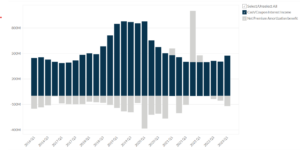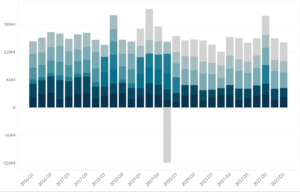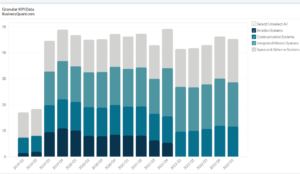
Global GPU Market Share (2010 – 2023)
Exclusive Data
You need the Pro Plan to access KPI data
- Full access to the platform
- KPI data & segment financials on US stocks
- Financial data on thousands of stocks
- Download data in xlsx and csv formats
Pro Plan
$49 per month*
60% discount ends in:
.
About
More information
Subscribe to Pro or Enterprise plans to unlock this feature.
Contact the Analyst
Subscribe to Pro or Enterprise plans to unlock this feature.
Become a smarter investor today.
Access KPIs & Segment Financials on US stocks
This article shows Global GPU Market Share, split between Nvidia and AMD, reported on a quarterly basis.
A GPU or Graphics Processing Unit is a specialized electronic circuit designed to swiftly manage and alter memory to speed up the processing of images in a frame buffer for output to a display device. GPUs are widely used in embedded systems, mobile phones, personal computers, workstations, and gaming consoles. Modern GPUs are extremely efficient when it comes to altering computer visuals and image processing. For algorithms that handle huge blocks of data in parallel, their highly parallel structure makes them more efficient than general-purpose central processing units (CPUs). A GPU can be found on either a video card or a motherboard. They are embedded on the CPU die in some CPUs.
The name “GPU” originally meant a graphics processor unit and described a programmable processing unit that worked independently from the CPU and was capable of visual manipulation and output. Cryptocurrency has created a new industry for GPUs. This is because cryptocurrency mining involves millions of calculations to add transactions to a blockchain, which may be profitable if you have access to a GPU and a cheap supply of power.
Global GPU Market Share
| Company | Q4 2016 | Q4 2017 | Q4 2018 | Q4 2019 | Q4 2020 | Q1 2021 |
| AMD | 29.50% | 33.70% | 18.80% | 31.08% | 17.00% | 20.00% |
| Nvidia | 70.50% | 66.30% | 81.20% | 68.92% | 83.00% | 80.00% |
In Q3 2016, the GPU market saw a general increase with growing shipment numbers. NVIDIA’s total GPU shipments grew by 39%, AMD’s shipments increased by 20%, and Intel’s GPU shipments increased by 18%. Nvidia’s market share grew from 70% in Q2 2016 to 70.90% in Q3 2016 due to an increase in their discrete GPU shipments. However, in Q4 2016 its share fell to 70.50%. AMD’s share increased to 29.50% during this period.
In Q3 2017, NVIDIA increased its discrete GPU market share to 72.8% compared to 69.70% in the previous quarter. AMD, on the other hand, saw its market share fall slightly to 27.2%. This was a rather interesting trend as AMD graphic cards were known to ship well when crypto mining was at its peak. NVIDIA graphics cards showed increasing demand over the crypto cycle, resulting in a higher market share at the conclusion. In the next quarter in Q4 2017, AMD’s market share saw a big increase to 33.70%, decreasing Nvidia’s share to 67.30%.
In Q4 2018, the GPU share for NVIDIA stood at 81.2% and that for AMD at 18.8%. The increase in Nvidia’s share was due to many changes that occurred during the preceding quarter, including the introduction of NVIDIA’s first Turing-based GeForce RTX 20 series graphics cards aimed at the $500 US+ category. AMD Radeon 590 was also released with a more mainstream sector approach.
In Q4 2019, AMD’s market share increased to 31.08% from 27.08% in the previous quarter. In contrast, Nvidia’s share fell from 72.92% to 68.92%. During Q4 2019, AMD released its long-awaited Polaris successor, the Radeon RX 5500 XT, while NVIDIA released both the GeForce GTX 1660 SUPER and GeForce GTX 1650 SUPER. AMD’s Polaris GPU witnessed a significant increase in sales and discounts, which might have contributed to the significant increase in market share. In addition, AMD introduced Navi GPUs for laptops, although they weren’t available until Q2 2020.
Nvidia increased its GPU share from 69.19% in Q1 2020 to 83% in Q4 2020, but it fell to 80% in Q1 2021. On the other hand, AMD’s share decreased from 30.89% in Q1 2020 to 17% in Q4 2020. AMD’s share grew by 3% in the next quarter to 20%, implying that its discrete GPU shipments and profitability improved as well.
While both Nvidia and AMD are experiencing significant supply and demand difficulties, Nvidia has been able to deliver a somewhat better flow of discrete graphics cards than AMD’s Radeon RX 6000 series. Cryptocurrency mining is another aspect that has contributed to NVIDIA’s increased market dominance. NVIDIA has taken steps to counter crypto mining operations by limiting hash rates on upcoming GeForce graphics cards. It has also announced its CMP lineup, which is dedicated to the crypto mining segment. AMD and Nvidia have recently announced performance-mainstream and laptop GPUs based on their newest RDNA 2 and Ampere architectures, implying that competition between the two companies might intensify.
About Nvidia
Nvidia Corporation was incorporated in California in 1993 by Jensen Huang, Chris Malachowsky, and Curtis Priem. Its headquarters is situated in Santa Clara California. Nvidia began with an emphasis on computer graphics. Nvidia’s first product, the NV1, was released in 1995. They released RIVA 128, the world’s first 128-bit 3D processor, in 1997. Almost one million gadgets were sold in the first four months. Nvidia unveiled the GeForce 256 in late 1999. (NV10). Before the GeForce 256, virtually all video cards were referred to as “graphics accelerators” or simply “video cards,” but Nvidia chose to refer to the GeForce 256 as a “GPU.” With this card, Nvidia included numerous new functions, including hardware T&L processing, which allowed the GPU to do computations that were previously reserved for the CPU.
About AMD
Advanced Micro Devices, Inc. (AMD) is a well-known manufacturer of graphics cards. The company, which was started by Jerry Sanders in Silicon Valley in 1969, manufactures high-performance computing and visualization equipment. The company produced its first product, the Am9300, a 4-bit MSI shift register that went on sale in 1970. AMD entered the GPU business in 2006 when it acquired ATI, the leading video card maker. AMD reorganized into two business groups on October 16, 2014: Computing and Graphics, which includes desktop and notebook processors and chipsets, discrete GPUs, and professional graphics, and Enterprise, Embedded, and Semi-Custom.
Did you like the Global GPU Market Share statistic?
Access thousands of more such key performance indicator data points, on listed companies, with Business Quant.
You can also get started for free.
More data on US Stocks

Our Plans
Always know what you’ll pay. No hidden costs or surprises.
- Annual
- Monthly
60% discount till April 30
Pro
For serious investing
-
Company KPI data Access segment financials, non-GAAP metrics and KPI data from presentations and filings. Examples include financials by segment / region / product category, AT&T's broadband subscriber trends, Tesla's deliveries by model and lots more.
-
Stock research tools Features include : stock screener, stock comparison, industry financials, stock warnings, advanced charting tools, timeseries tables, scatter charts, financial statements, stock reports, SEC filings, stock ratings, institutional and insider ownership data. There are 200+ financial items and ratios on thousands of US stocks.
-
Industry data & tools Access premium operating data on 40+ industries. Examples include market share, smartphone shipments by vendor, subscribers by wireless carrier, historical gold production. There are 20,000+ such statistics.
Enterprise
For tailored workflows
-
All of Pro plan Get unfettered access to all our dashboards and dossiers.
-
Custom built features Get tailored dashboards built specially for you , based on your set of requirements, to simplify your research workflow.
-
Admin billing Back-end documentation support and multi-seat licensing.
* Billed annually, local taxes extra.
60% discount on Annual plan
Pro
For serious investing
-
Company KPI data Access segment financials, non-GAAP metrics and KPI data from presentations and filings. Examples include financials by segment / region / product category, AT&T's broadband subscriber trends, Tesla's deliveries by model and lots more.
-
Stock research tools Features include : stock screener, stock comparison, industry financials, stock warnings, advanced charting tools, timeseries tables, scatter charts, financial statements, stock reports, SEC filings, stock ratings, institutional and insider ownership data. There are 200+ financial items and ratios on thousands of US stocks.
-
Industry data & tools Access premium operating data on 40+ industries. Examples include market share, smartphone shipments by vendor, subscribers by wireless carrier, historical gold production. There are 20,000+ such statistics.
Enterprise
For tailored workflows
-
All of Pro plan Get unfettered access to all our features.
-
Custom built features Get tailored dashboards built specially for you , based on your set of requirements, to simplify your research workflow.
-
Admin billing Back-end documentation support and multi-seat licensing.
* Local taxes extra.






